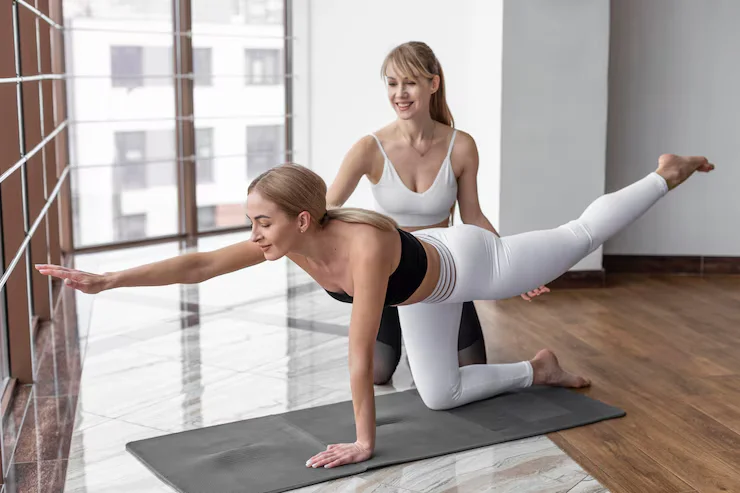Pilates vs Yoga
While pilates and yoga may appear similar, each has unique methods, principles, and benefits. However, both deliver excellent results and are specifically beneficial during physical therapy and injury recovery. In this article, we’ll discuss pilates vs yoga to help you decide which suits your fitness journey best!
Pilates vs Yoga
Before choosing a fitness routine that includes yoga or Pilates, it’s important to consider your preferences and goals. For building strength and mobility, Pilates exercises might be the ideal choice. On the other hand, if your focus is on enhancing endurance, flexibility, and mental clarity, yoga could be a better fit for you.
Types of Yoga
Pranayama Yoga
Pranayama exercises focus on controlled breathing and mindfulness, with the term “prana” derived from Sanskrit, meaning “life force.” These exercises reduce stress and anxiety, improve lung function and help with conditions like irritable bowel syndrome. Some of these techniques include:
- Three-Part Breathing (Dirga Pranayama)
- Alternate Nostril Breathing (Nadi Shodhana)
- Ocean Breathing (Ujjayi Pranayama)
- Cooling Breath (Shitali Pranayama)
Hatha Yoga
Hatha Yoga is one of the most widely practiced forms of yoga, known for its focus on balance, endurance, and mindfulness. While it can be challenging due to its emphasis on slow, deliberate movements and strong poses, it is a popular choice for those seeking both physical and emotional benefits. Common poses include:
- Mountain Pose (Tadasana)
- Downward Facing Dog (Adho Mukha Svanasana)
- Warrior II (Virabhadrasana II)
- Triangle Pose (Trikonasana)
- Bow Pose (Dhanurasana)
Chair Yoga
Chair Yoga is a gentle and accessible form of yoga, ideal for those who find traditional yoga poses challenging or prefer a seated practice, making it suitable for people of all fitness levels, including individuals with limited mobility.
Vinyasa Yoga
Often called “flow yoga,” is a dynamic practice that links breath with movement to create smooth transitions between poses. This style emphasizes fluidity, with each movement synchronized to an inhalation or exhalation. From gentle and slow to fast-paced and challenging poses, including:
- Uttanasana (Forward Fold)
- Ardha Uttanasana (Half Lift) – Spine straight, hands on shins
- Chaturanga Dandasana (Four-Limbed Staff Pose)
- Tadasana (Mountain Pose)
- Bhujangasana (Cobra Pose)
- Urdhva Hastasana (Upward Salute)
Asana Yoga
The term yoga asana refers to the body postures and positions, originally referred to a still, comfortable position suitable for meditation. From simple seated poses to advanced balancing postures, yoga asanas prepare the body and mind for relaxation, meditation, and spiritual growth.
Benefits of Yoga
- Improving balance
- Enhancing sleep quality
- Reducing knee osteoarthritis pain
- Alleviating stress and stress-related conditions, such as tension headaches
- Supporting weight loss
- Easing some symptoms of menopause
- Relieving lower back and neck pain
Types of Pilates
Classical Pilates
The original form, staying true to the methods and principles. Classical Pilates strictly follows the original sequences, emphasizing alignment, breathing, and concentration to ensure each movement is intentional and effective. This practice flows seamlessly from one exercise to the next, offering a full-body workout.
Wall Pilates
Wall Pilates is a modern variation of traditional Pilates that incorporates a wall for support and resistance. The wall helps hold the body in place, making movements more effective and accessible for people of all fitness levels.
Clinical Pilates
Clinical Pilates is a specialized form of Pilates used in physiotherapy to address specific chronic conditions like back pain or joint problems and injuries. Focusing on post-surgery rehabilitation and recovery. It involves low-impact movements designed to alleviate pain and restore function in a safe and effective manner.
Equipment Pilates
This is specifically designed to enhance your workout by providing resistance and support, making it easier to perform movements that target all areas of your body with greater control.
Equipment can increase the precision and intensity of your workout while keeping the impact on your joints low.
Benefits of Pilates
- Increased flexibility
- Increased core strength to improve stability
- Improved posture
- Relieved lower back pain
Is there yoga specifically for pregnant women?
Yes, there are yoga practices specifically for pregnant women, designed to support their changing bodies.
Can Pilates help with weight loss?
Yes, Pilates can contribute to weight loss by improving muscle tone and enhancing metabolism.
If you’re contemplating pilates vs yoga and don’t know what to choose, consult a specialized trainer to find the best approach for your needs.







